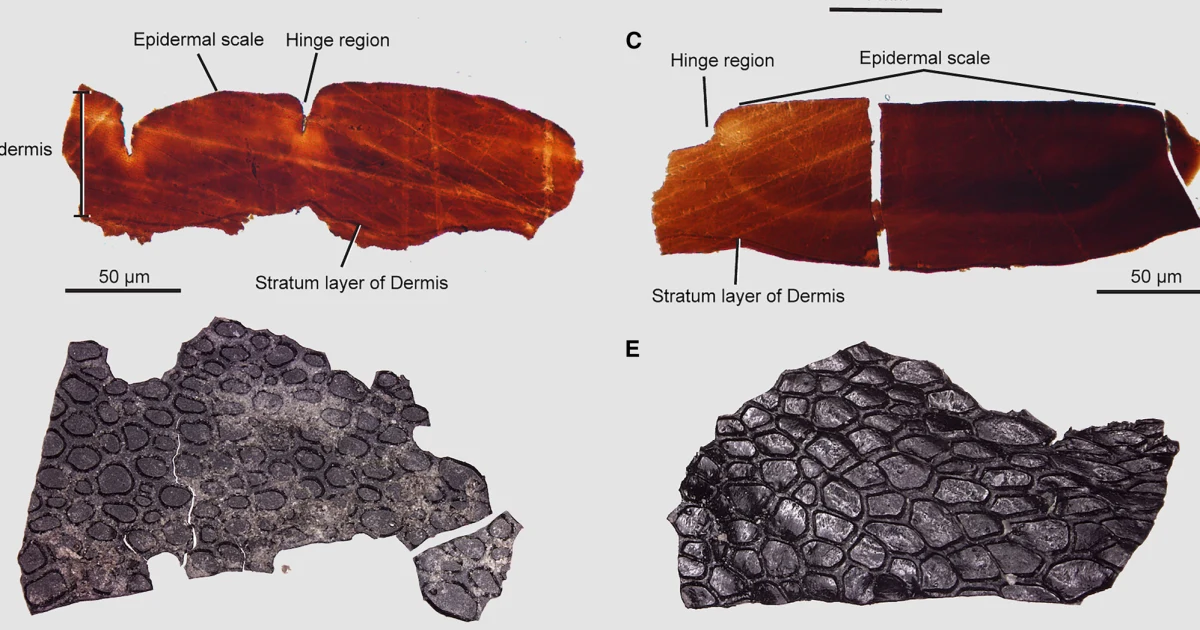In the annals of paleontological exploration, a riveting chapter has unfolded with the recent revelation of the oldest fossilized skin ever discovered. Akin to a time capsule preserved within the ancient, subterranean embrace of Richards Spur, this crocodile-like skin, dating back an astonishing 286 million years, has captivated the scientific community and ignited imaginations worldwide. The geological marvel of Richards Spur, a quarry and cave system in present-day Oklahoma, served as the clandestine repository where creatures of a bygone era met their fate, only to be preserved through the eons by the transformative alchemy of oil and tar.
This unprecedented discovery has not only unveiled a remarkably well-preserved 3-dimensional cast of ancient skin but also opens a window into a world obscured by the sands of time. Ethan Mooney, a graduate student at the University of Toronto and a lead author in this scientific odyssey, aptly describes it as an exceptional opportunity to peer into the past and glean insights into the appearance of Earth’s earliest creatures during their transition to terrestrial life. As we embark on this journey through the epochs, we unravel the mysteries embedded in the layers of time, exploring the geological nuances, the scientific significance, and the tantalizing potential of this ancient crocodile-like skin to rewrite the narratives of our planet’s ancient history.
The Oldest Fossilized Skin Discovery
In the realm of paleontology, a groundbreaking revelation has emerged: scientists have uncovered the oldest fossilized skin ever discovered. This awe-inspiring find, a crocodile-like skin dating back at least 286 million years, is poised to reshape our understanding of Earth’s ancient inhabitants. Let’s embark on a journey through time and explore the significance of this extraordinary discovery.
The Setting for an Ancient Discovery
The stage for this revelation is Richards Spur, a quarry and cave system in present-day Oklahoma. This geological marvel, a treasure trove for paleontologists, played host to the preservation of this ancient crocodile-like skin. The intricate interplay of natural elements, including oil and tar, created a time capsule that encased the creatures within, providing an unparalleled glimpse into a bygone era.
A 286-Million-Year-Old Crocodile-Like Skin
Dive deep into the details of this remarkable find—crocodile-like skin that has endured the passage of time for a staggering 286 million years. Preserved within an ancient, infilled cave, this 3-dimensional cast with attached fossilized tissue is a testament to the unique conditions that allowed for such extraordinary preservation. This section delves into the specifics of the skin’s composition and the clues it holds about Earth’s ancient landscapes.
Ethan Mooney’s Perspective
Meet Ethan Mooney, a graduate student at the University of Toronto and a lead author of the paper unveiling this historic discovery. Gain insights into Mooney’s perspective on the exceptional opportunity presented by this ancient skin fossil. His reflections on peering into the past and deciphering the appearance of early creatures offer a human touch to the scientific journey.
Contextualizing the Skin Discovery
Delve into the contextual background of the discovery site, where fossils of lizard-like creatures named Captorhinus aguti abound. This section explores the connection between the discovered skin and the potential implications for understanding the evolutionary split between reptiles and mammals. How does this ancient skin contribute to unraveling mysteries deeply embedded in Earth’s biological history?
The Future Implications of the Ancient Skin Discovery
As we conclude our exploration, peer into the future implications of this ancient skin discovery. From potential revelations about the common ancestor of reptiles and mammals to the broader insights it may offer about Earth’s evolutionary timeline, this section discusses the enduring impact of this remarkable find on the trajectory of paleontological research.
Conclusion
In concluding this remarkable expedition through time and discovery, the unveiling of the oldest fossilized skin stands as a testament to the resilience of Earth’s ancient relics. Richards Spur, with its geological alchemy, has gifted us a rare glimpse into a world that predates recorded history. The crocodile-like skin, a silent witness to eons gone by, sparks contemplation on the mysteries that still lie shrouded in Earth’s layers.
Ethan Mooney’s sentiment, echoed throughout this exploration, encapsulates the significance of this find—an exceptional opportunity to connect with the past and decipher the enigma of Earth’s earliest inhabitants. As the scientific community continues to unravel the intricacies held within this ancient skin, it beckons us to ponder the profound interconnectedness of all life, past and present. This discovery, echoing through the corridors of time, will undoubtedly leave an indelible mark on our understanding of the evolutionary tapestry that weaves through the ages.

